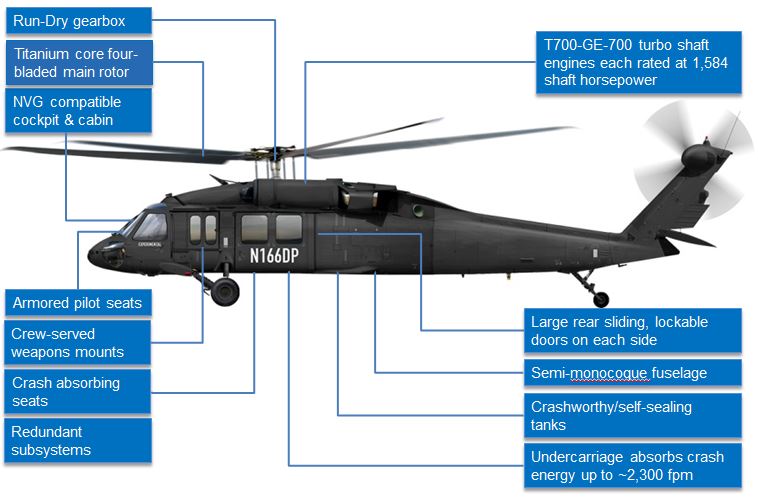Specialist Insights: Enhancing Efficiency in UH 60 Helicopter Operations
Specialist Insights: Enhancing Efficiency in UH 60 Helicopter Operations
Blog Article
Comprehending the Mechanics and Design Behind Uh 60 Helicopters
The UH-60 helicopter, commonly understood as the Black Hawk, stands as a peak of modern rotorcraft innovation, personifying a blend of durable design and intricate auto mechanics. As we peel off back the layers of the UH-60's layout, a world of elaborate systems and careful design comes to light.
Background of UH-60 Helicopters
The background of UH-60 helicopters traces back to the late 1970s when the USA Military sought a advanced and versatile utility helicopter to change its aging fleet. In reaction to this requirement, the Sikorsky Aircraft Firm created the UH-60 Black Hawk helicopter. Presented in 1979, the UH-60 rapidly became a staple in army procedures because of its outstanding capabilities.
The UH-60 was made to master a range of missions, consisting of troop transport, clinical emptying, electronic war, and special procedures. Its capability to adapt to various functions made it a valuable property to the U.S. uh 60. Military and other military pressures around the world
For many years, the UH-60 system has gone through several upgrades and variants to enhance its efficiency and keep pace with advancing objective needs. These helicopters have seen substantial service in problems such as the Gulf War, Afghanistan, and Iraq, showcasing their integrity and adaptability in diverse functional atmospheres. The UH-60's rich history is a testimony to its enduring heritage as a leading energy helicopter.

Engine and Power Solutions
Utilizing cutting-edge propulsion innovation, UH-60 helicopters are furnished with sophisticated engine and power systems to make sure optimum performance and reliability in a variety of operational circumstances. The UH-60, frequently referred to as the Black Hawk, is powered by 2 General Electric T700-GE-701D engines, each efficient in providing up to 1,940 shaft horsepower. These turboshaft engines offer the necessary drive for the helicopter to accomplish its missions efficiently, including army transportation, medical discharge, and battle support.

Rotor System and Aerodynamics
Exactly how do the blades system and the rules of aerodynamics of UH-60 helicopters contribute to their functional effectiveness and trip capabilities? The blades system of the UH-60 helicopter plays a critical function in providing lift and propulsion.
The rules of aerodynamics likewise play an essential role in the performance of UH-60 helicopters. The structured fuselage and rotor blade layout minimize drag, enabling the helicopter to achieve greater speeds and better gas performance. The aerodynamic layout of the UH-60 likewise adds to its ability to operate in varied ecological conditions, including high elevations and warm temperatures.
Avionics and Flight Control Systems

In its complex control with the rotor system and aerodynamics of UH-60 helicopters, the avionics and trip control systems create a critical network of technologies forming the airplane's operational capabilities. Avionics include the digital systems utilized for interaction, navigating, and keeping track of different aircraft functions. In the UH-60, these view it now systems include digital screens, interaction radios, general practitioner navigating, weather radar, and autopilot systems. These avionics systems supply essential info to the pilots, boosting situational awareness and ensuring efficient and risk-free procedure of the helicopter.
The flight control systems of the UH-60 are accountable for translating the pilot's inputs right into the proper modifications to the rotor system, making sure steady flight and maneuverability. These systems consist of hydraulic actuators, servos, and computer systems that interact to manage the major and tail blades, in addition to other flight control surface areas. By exactly managing the helicopter's trip dynamics, these systems make it possible for pilots to carry out a wide array of objectives, from transportation and search-and-rescue to that site fight procedures, with precision and self-confidence.
Role and Applications in Aeronautics
Avionics systems in UH-60 helicopters encompass a range of electronic systems that aid in navigation, interaction, surveillance, and regulating numerous airplane functions. These systems include electronic screens, autopilot systems, communication radios, General practitioner navigating equipment, and climate radar. Additionally, these systems incorporate safety attributes such as auto-pilot modes, terrain recognition advising systems, and security augmentation systems to enhance the total security and operational capabilities of the UH-60 helicopters in numerous goals, including army transportation, medical discharge, search and rescue, and airborne firefighting.
Final Thought
To conclude, the UH-60 helicopter is a versatile airplane with a rich history and progressed engineering. Its engine and power systems, rotor system, the rules of aerodynamics, avionics, and trip control systems all interact to make it a dependable and efficient equipment. The UH-60's function and applications in aeronautics are substantial, ranging from army operations to check this search and save objectives. Its continued growth and use demonstrate its relevance in the field of aviation (uh 60).
In its complex coordination with the rotor system and the rules of aerodynamics of UH-60 helicopters, the avionics and flight control systems develop a critical network of technologies forming the aircraft's operational capacities.The flight control systems of the UH-60 are responsible for equating the pilot's inputs right into the ideal adjustments to the blades system, making certain secure flight and ability to move. Avionics systems in UH-60 helicopters include a variety of electronic systems that aid in navigating, interaction, monitoring, and regulating different airplane features. Furthermore, these systems incorporate security functions such as auto-pilot modes, surface understanding advising systems, and security augmentation systems to improve the general safety and security and operational capabilities of the UH-60 helicopters in numerous goals, consisting of army transportation, medical evacuation, search and rescue, and aerial firefighting.
Its engine and power systems, rotor system, aerodynamics, avionics, and flight control systems all work with each other to make it a trusted and effective device.
Report this page